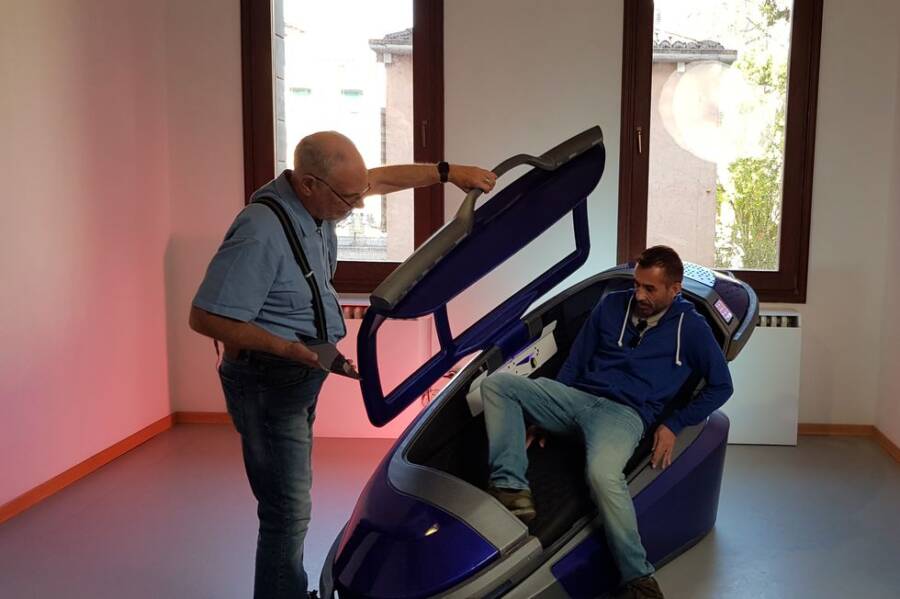The brainchild of Lithuanian artist Julijonas Urbonas, the Euthanasia Coaster reaches 1,600 feet high, runs 4.5 miles long, and tops out at 220 miles per hour.

Julijonas UrbonasA scale model of the Euthanasia Coaster.
Roller coasters often have extreme names like the Millennium Force, the Raging Bull, or the Top Thrill Dragster, but there generally tends to be one topic rollercoaster naming conventions avoid: death.
There have certainly been gruesome deaths caused by amusement park rides, but these were, of course, accidental. No one has ever actually designed a rollercoaster with the intent of killing its passengers — right?
Well, that was the case until 2010, when artist Julijonas Urbonas debuted his design for the Euthanasia Coaster, “a hypothetic roller coaster, engineered to humanely — with elegance and euphoria — take the life of a human being.”
It may seem dark and morbid, but Urbonas has stood by his belief that the ride really would kill its passengers in a thrilling fashion, rather than a painful one. Read on to learn everything you need to know about the Euthanasia Coaster.
How Would The Euthanasia Coaster Work?
Rollercoaster euthanasia isn’t exactly the most commonly discussed form of assisted suicide, so there were naturally many questions about how this hypothetical coaster would operate.
In 2014, Vice interviewed Julijonas Urbonas, who, in addition to being an artist, was also an associate professor at Vilnius Academy of Arts in Lithuania and a former director of a Soviet amusement park in Klaipeda.
One question surrounding the Euthanasia Coaster involved the usage of the words “euphoric” and “elegant” in Urbonas’ description. As he explained, these terms “refer to both the physiological as well as aesthetic and ethical definitions of pleasure.”

Julijonas Urbonas/Wikimedia CommonsJulijonas Urbonas (left) standing next to his scale model of the Euthanasia Coaster.
The ride would only hold a sole passenger in a single-coaster cart, carry them up a hill reaching 1,600 feet, and allow the rider a few minutes of contemplation should they decide to abandon their fatal ride.
If they chose to go through with it instead, they would press the “fall” button, and the cart would proceed down the steep drop at 220 miles per hour.
At this point, the cart would no longer be accelerating, as it would be falling so quickly that the force of the air drag would be equivalent to the force of gravity. So, reaching the crux of the first loop, your internal organs and ribs would be pushed down and squeeze all of the air from your lungs — therefore reducing the oxygen flow to your brain.
The first loop of the coaster is meant to make the rider experience GLOC — G-force-induced loss of consciousness — which would induce cerebral hypoxia. This condition occurs when the brain does not get enough oxygen and can often be accompanied by a sensation of euphoria.
And if that first loop doesn’t knock you out, Urbonas designed several increasingly smaller loops to come after, ensuring GLOC will kick in. After several loops, various things will happen to your body. You’ll likely start to lose vision. The world will look blurry or possibly even colorless; you could even lose hearing.
By the end of the ride, you’re all but guaranteed to be dead. Urbonas also noted that the cart would be equipped with a health monitoring system for double assurance. If you reach the end alive, there’s always the possibility of going for round two.
Could You Survive The Euthanasia Coaster?

Julijonas UrbonasA conceptual drawing of Julijonas Urbonas’ Euthanasia Coaster.
After showing off a scale model of the Euthanasia Coaster in 2011, Urbonas’ macabre machine concept made the rounds on social media and garnered a significant amount of interest — and that included scientists and pilots.
As Urbonas revealed in a 2021 interview with LADBible, there is one possible way to survive the Euthanasia Coaster.
“A possible usage is the ‘hacked’ thrill ride,” Urbonas said, “which was suggested to me by an aeronautic engineer who visited the coaster’s scale model during an exhibition. She said, ‘Your machine could be hacked, you know.'”
At the core of Urbonas’ concept is the manipulation of gravity and G-force to essentially pull the blood from a rider’s brain down into the lower half of their body. This could be prevented, however, by wearing “anti-g trousers,” or a g-suit, a suit worn by astronauts and aviators to stop them from losing consciousness during acceleration.
In theory, the g-suit could do the same thing for a Euthanasia Coaster rider, preventing their blood from pooling in the lower half of their body.

Wikimedia CommonsAn anti-g-suit, or simply a g-suit, could theoretically prevent death on the Euthanasia Coaster.
“Using anti-g trousers that prevent pilots from blackout and fainting,” Urbonas said, “I believe I would survive the ride and turn it into the most extreme thrill ride.”
The design concept was so groundbreaking, in fact, that it was awarded the Public Prize of New Technological Art of Update 2013. Still, what would inspire Urbonas to come up with this idea in the first place?
“There are actually several sources of inspiration,” he told Vice. “They’re quite diverse, but all of them have something in common. The key ones might be the halt of roller-coaster progress, the extinction of death rituals, and the current development in sci-fi design.”
Urbonas also said that a sci-fi enthusiast reached out to him, drawing comparisons between the Euthanasia Coaster concept and the works of Kurt Vonnegut, who often featured euthanasia as a theme in his stories.
From interviews, it’s clear that Urbonas viewed his work, at least in part, as a cross-section between science fiction, art, architecture, and a truly viable solution for assisted death, which can be a touchy subject, depending on where you are in the world. Certainly, it makes the actual implementation of something like the Euthanasia Coaster a complicated maneuver — but it’s not actually that far off from some other solutions around the world.
Another Futuristic Assisted Death Invention
As Popular Mechanics reported in 2021, an Australian nonprofit, Exit International, designed what they call the Sarco suicide pod (short for sarcophagus), which was approved for use by Switzerland’s medical review board.
The pod, which looks like something straight out of a sci-fi movie, has an incredibly similar goal to the Euthanasia Coaster: to make death as quick and euphoric as possible.
The way it works is fairly straightforward. Someone wanting to undergo voluntary euthanasia or assisted suicide lies down in the pod. They are then asked a series of simple questions, and once they’ve answered, they are free to push the big red button inside the pod.

Exit InternationalTwo men demonstrate the Sarco pod.
At this point, a canister of liquid nitrogen is dispensed into the pod, dropping oxygen levels to less than five percent in just one minute. Unlike poisonous gases, though, pure nitrogen has no smell, nor is it toxic. Like the Euthanasia Coaster, the point of using nitrogen is to decrease oxygen, which will create a euphoric effect on the person inside. Death, in this instance, stems from oxygen deprivation and a hyper-concentration of carbon dioxide in the blood.
The whole process takes a maximum of 10 minutes.
The pod itself is also biodegradable and can be detached to be used as a coffin.
There is a strong ethical debate around the concept of assisted death — and that is perhaps why the Euthanasia Coaster made such a big impression — but Exit International founder Philip Nitschke argued that the Sarco pod is a far more humane solution than other assisted suicide methods available in Switzerland. It doesn’t involve injecting drugs into a person’s body, for example, or asking a patient to overdose on drugs that could cause them to vomit.
The Sarco pod and the Euthanasia Coaster both offer unique solutions to a rather controversial topic, but more than anything else, they bring that conversation into a more public lens — for better or worse.
Looking for more weird science? See how the people of the past imagined the future of today through these 55 pieces of astonishing retrofuturism art. Or, learn the full story about who invented the internet.





